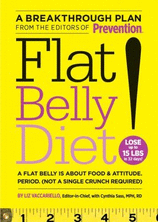
June 2, 2009
Diet for a Flat Belly?
Recently, one of my students presented me with a copy of a book called, “The Flat Belly Diet.” A catchy title, no doubt. After all, who wouldn’t be enticed by a diet that claims to selectively target the fat around your midsection and flatten your stomach by simply eating certain foods?
 The concept of the “Flat Belly Diet” is fairly simple. Basically, it professes that in order to lose your gut you need to eat a diet rich in monounsaturated fats (MUFAs)–a type of fat found in olive oil, avocados, and certain nuts. The impetus for this theory was derived from a study in the journal Diabetes Care, which showed that a MUFA-rich diet tended to reduce abdominal fat stores to a greater degree than those who ate a high-carb diet. While on the surface this might seem like a ground-breaking discovery, several things need to be kept in mind. First off, the sample size of the study consisted of only 11 subjects–a very small number for a study of this scope. What’s more, the subjects were all Type II diabetics. It’s purely speculative as to whether similar results would be realized in those who aren’t diabetic (and logic would lead me to believe that many wouldn’t). There also was no mention as to the types of carbs consumed by the subjects. There is a BIG difference between eating a bowl of oatmeal vs. a bowl of Frosted Flakes, despite the fact that both are largely carbohydrate based. Yet this wasn’t addressed anywhere in the study.
The concept of the “Flat Belly Diet” is fairly simple. Basically, it professes that in order to lose your gut you need to eat a diet rich in monounsaturated fats (MUFAs)–a type of fat found in olive oil, avocados, and certain nuts. The impetus for this theory was derived from a study in the journal Diabetes Care, which showed that a MUFA-rich diet tended to reduce abdominal fat stores to a greater degree than those who ate a high-carb diet. While on the surface this might seem like a ground-breaking discovery, several things need to be kept in mind. First off, the sample size of the study consisted of only 11 subjects–a very small number for a study of this scope. What’s more, the subjects were all Type II diabetics. It’s purely speculative as to whether similar results would be realized in those who aren’t diabetic (and logic would lead me to believe that many wouldn’t). There also was no mention as to the types of carbs consumed by the subjects. There is a BIG difference between eating a bowl of oatmeal vs. a bowl of Frosted Flakes, despite the fact that both are largely carbohydrate based. Yet this wasn’t addressed anywhere in the study.
Now I have no qualms with recommending a diet that is rich in MUFA’s. They’ve been shown to be heart healthy and have beneficial metabolic effects. Specifically, when compared to saturated fats, consumption of MUFAs have been shown to result in less fat accumulation, even when caloric intake is similar. But MUFAs aren’t the only type of fat that confers such benefits. Omega 3 fats–a polyunsaturated fatty acid–show similar metabolic efficiencies as well as having a positive impact on numerous aspects of health and wellness. Given that omega-3s are “essential” fats (meaning the body can’t produce them naturally and that an absence causes disease), they are unquestionably a more important dietary nutrient than MUFAs. Yet there is little mention of omega-3s in the “Flat Belly Diet”.
Perhaps the biggest failing of the book is that it doesn’t focus on the most important nutrient for fat loss: protein. Protein confers numerous metabolic advantages for those seeking to optimize body composition. First, it increases satiety. Studies have clearly shown that when you eat higher amounts of protein, your appetite decreases, causing you to eat less food. Reduce calories and you lose weight, pure and simple. More importantly, a higher protein intake helps to preserve lean muscle while dieting. It has been well documented that if protein intake isn’t maintained when calories are restricted, people lose considerable muscle mass. The significance here is that muscle is metabolically active tissue. Lose muscle and your metabolism slows to an eventual crawl. You end up hitting a weigh loss plateau and ultimately you gain back what you lost and more.
Bottom line: There is nothing magical about the “Flat Belly Diet.” Don’t expect to go on this diet (or any diet, for that matter), and expect to selectively slim down your waistline. Proper nutrition during dieting requires sufficient protein to attenuate muscle loss (generally around 2 grams of protein per kilogram of body weight). And while monounsaturated fats are certainly beneficial, it’s more important to focus on increasing the amount of omega-3 fats in your diet. In addition to being highly bio-active, they have proven to confer numerous health and wellness benefits in ways that no other dietary fat can.
As always, be an educated consumer don’t fall for the hype.
Stay Fit!
Brad
No Comments
No comments yet.
RSS feed for comments on this post.
Sorry, the comment form is closed at this time.





 Entries (RSS)
Entries (RSS)



